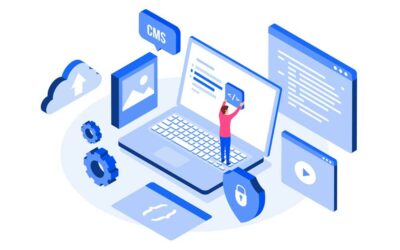It used to be said that technology can change the way we work and live. Now that we’re in the year 2023, innovations in digital technology continue to shape and influence how we run businesses and manage our daily routines.
Thus, it’s no longer accurate to use “change” to describe the effect of technology on the world. Change is temporary. What we are going through is a transformation – a digital transformation.
What Is Digital Transformation?
Digital transformation is the application of advanced technological innovations in order to improve the efficiency of workflows, processes, and systems for the purposes of managing strategies, enhancing customer experiences, and achieving business goals.
As an entrepreneur, you want to leverage the advantages of the latest digital innovations to make it easier to manage your business. You can streamline costs, boost productivity, and incorporate processes that will keep your customers happy.
You’ve experienced digital transformation in your everyday life.
Gone are the days of hailing a cab. Today, all you have to do is use a ride-hailing app. No time to grocery shop? There are apps that allow you to have groceries delivered to your home.
Everything that you need to do can be done from your mobile phone. Multi-tasking has become the norm. You could be at the gym following a fitness program designed by an app and in between rest periods, pay your bills via online banking.
Consumers have adapted to digital transformation. So should your business. You want your customers to be happy and satisfied with your products and after-sales service.
How Your Business Benefits From Digital Transformation
With the availability of new apps, software programs, and portable hardware, it will be easier for you to upgrade your business model by integrating – and embracing – digital technology.
Your business can benefit from digital transformation in a number of ways.
1. Reduce Business Costs – Save up on paper costs and your phone bill by shifting your processes to project management apps such as ClickUp, Asana, and Monday.com.
You can upload, share, and store files in these project management apps which are protected by high-level security programs. No need for frequent printing of hard copies.
Communicate with your team by using Viber, Slack, Messenger or Skype. You can set up online meetings in case your team works remotely or send chat messages for more detail.
2. Increase Productivity – By integrating digital technology into your workflows, people can work from remote locations. They can start working on tasks once they get up in the morning – or after the first cup of coffee.
Employees who are given the option of working from home are also happier and generally more productive.
3. Improve Customer Service – The integration of chatbots in websites and social media pages has given businesses a new avenue to handle customer service.
As you’ll learn later in this article, Artificial Intelligence (AI) has taken customer support services another level up. AI has reduced the queueing time for customers who want their concerns addressed immediately.
4. Build Your Business Brand – If a customer goes to your office and notices that you’re still using 486 computers, dot matrix printers, and fax machines, chances are they won’t do business with you.
Keeping your business updated on the digital technology front tells customers that you’re committed to providing excellent service.
Also, that you’re serious about running the #1 business in the industry. Keep in mind that your competitors are harnessing the power of digital technology as well.
5. Expand Your Market Reach – With an e-commerce website, your products and services will be more accessible to potential customers. In comparison to a brick-and-mortar store, your e-commerce store is open 24/7. Your checkout counter could stay busy while you’re asleep.
By having an online presence, you can expand your market reach. Your business might be found by foreign companies and become interested in buying your products or acquiring your services.
Digital transformation can help make your business become profitable by reducing costs, increasing productivity, improving customer retention, and enhancing your visibility to potential new clients or customers.
5 Digital Transformation Trends In 2023
If you’re concerned about digital transformation because you’re intimidated by technology, don’t be. Remember that technology continues to evolve in order to develop innovations that will make life and work easier.
It might seem complex but what’s important to keep in mind is that innovation exists to simplify processes and not to complicate them.
Here are 5 digital transformation trends you should watch out for in 2023.
1. AI and ML Technology
Technology company Servion Global Solutions predicts that by 2025, AI and ML technologies will manage 95% of all interactions with customers.
According to the study by Servion, while customers are happy with the performance of chatbots, they want something better. And that something is AI technology.
Unlike chatbots which are limited by default answers to a fixed set of FAQs, AI will be equipped with technology that will allow them to interact freely with customers.
AI will have the capability to handle inbound customer calls and online chat support services and provide feedback in real time. Customers won’t have a clue that they’re dealing with an AI because the interactions are seamless.
In November 2022, OpenAI launched ChatGPT, a chatbot that was developed with features that allowed the program to improve its ability to learn and understand human behavior in order to articulate the proper response.
Although ChatGPT has its set of flaws, the chatbot is seen as a watershed moment in digital transformation and the continued evolution of AI technology.
Machine Learning or ML is a form of technology whereby computers are able to fully learn and understand the behavior and decision-making processes of customers.
The integration of ML technology will help businesses optimize the data they are gathering from users. Businesses will be able to come up with better choices and recommendations for their customers.
The combination of AI and ML technologies will guide businesses toward designing and developing more effective customer-centric strategies.

2. Cloud-based Infrastructure And XAAS
Investing in Cloud-based technology infrastructure will streamline processes, speed up communication, improve data security, and make it easier for businesses to scale up operations.
A typical cloud-based infrastructure can manage the following functions of a business:
- Data storage
- Information sharing/transmission
- Data management
- Establishment of communication channels
- Network security
- Analytics and report generation
- Customer support
Setting up cloud-based infrastructure won’t be expensive because many of these platforms already exist. Some of the services are for free and for more advanced features, there’s a subscription cost that’s affordable for most businesses.
In fact, businesses have recognized the shift to cloud-based technology that many have packaged their offerings into monthly subscription-based services. This business model is called Everything As A Service of XAAS.
A good example is Google Workspace where users can avail of software programs and apps that can manage multiple functions such as spreadsheet/accounting, document writing, calendar management, file storage/sharing, and communication.
Having cloud-based infrastructure available will make your business more flexible and adaptable to changes in the industry and the economic landscape. You can easily integrate telecommuting arrangements in the workforce or hire remote workers across the globe to significantly reduce overhead.
3. Telecommuting/Hybrid Work Arrangement
Telecommuting is not a passing fad. Telecommuting has merged work and home life and is here to stay.
Telecommuting is an employment model whereby employees split their days working from home and the office. This employment model has become a necessity because of the 2020 pandemic. People realized they need to spend more time at home and that it was possible to have a career as a remote worker.
Its acceptance as an alternative working arrangement has given it a new name “Hybrid Work”.
The need to integrate Hybrid work in the workplace is one of the driving factors in the rise in demand for cloud-based infrastructure. For the Hybrid work arrangement to succeed, it must be supported by a seamless and comprehensive cloud-based network.
4. RPA Technology And User-Friendly, Low to No-Code Platforms
Processes are designed with efficiency in mind. The more tasks you can accomplish within a given time frame, the more productive the effort. To make processes more efficient, expect RPA or Robotic Process Automation to become a mainstay solution for many businesses.
RPA can be used to manage repetitive and recurring tasks such as data entry, accounting/payroll processing, and invoice management.
Another possible solution is to incorporate low to no-coding platforms with easy-to-use, highly interactive, and navigable interfaces that almost any employee can use to create automated processes.
Whichever solution you want to adopt to your business, you’ll certainly save time and money while giving productivity a boost.
5. Tighter Cyber-Security Systems
As more businesses migrate their processes online and invest in multiple digital tools and platforms, the incidence of cyber attacks and hacking attempts will increase.
While honest, well-meaning IT professionals work to create programs that help businesses become profitable, cybercriminals develop hacking and malware software that steal these opportunities for profit for their benefit.
It’s a race that will never end as hackers will try to stay ahead of software and app developers. If you’ve decided to invest in digital transformation, including the latest, top-of-the-line cyber security programs on the list of priority processes.
Consumers are very much aware of the risk of transacting online. They prefer to deal only with businesses that have shown a commitment to ensuring the safety, protection, and integrity of their data.
A subject matter that’s hardly discussed by businesses with their customers is how their data is being used. Other than assuring users of having the best site security protocols in place, exercise transparency with your customers to further enhance trust.
Share your data privacy policy and secure their permission before accessing their financial information.
Conclusion
We could easily come up with a Part 2 of this article because there are other digital transformation trends on the horizon. We haven’t touched on Augmented Reality (AR), Virtual Reality (VR), hologram technology, and Enterprise Resource Planning.
What’s clear is the end goal of digital transformation – to create the best customer experience.
At the heart of the battle for market share is the customer. If a customer is happy with his experience transacting with you and is impressed with the technology features in place, he will choose to patronize your business.
Are you ready to level up your business and digitally transform your business in 2023 and beyond? Give us a call or drop us an email and we’ll chart your course for the future.
Your customers will be happy!
And if you enjoyed this article, feel free to share it with your community.






